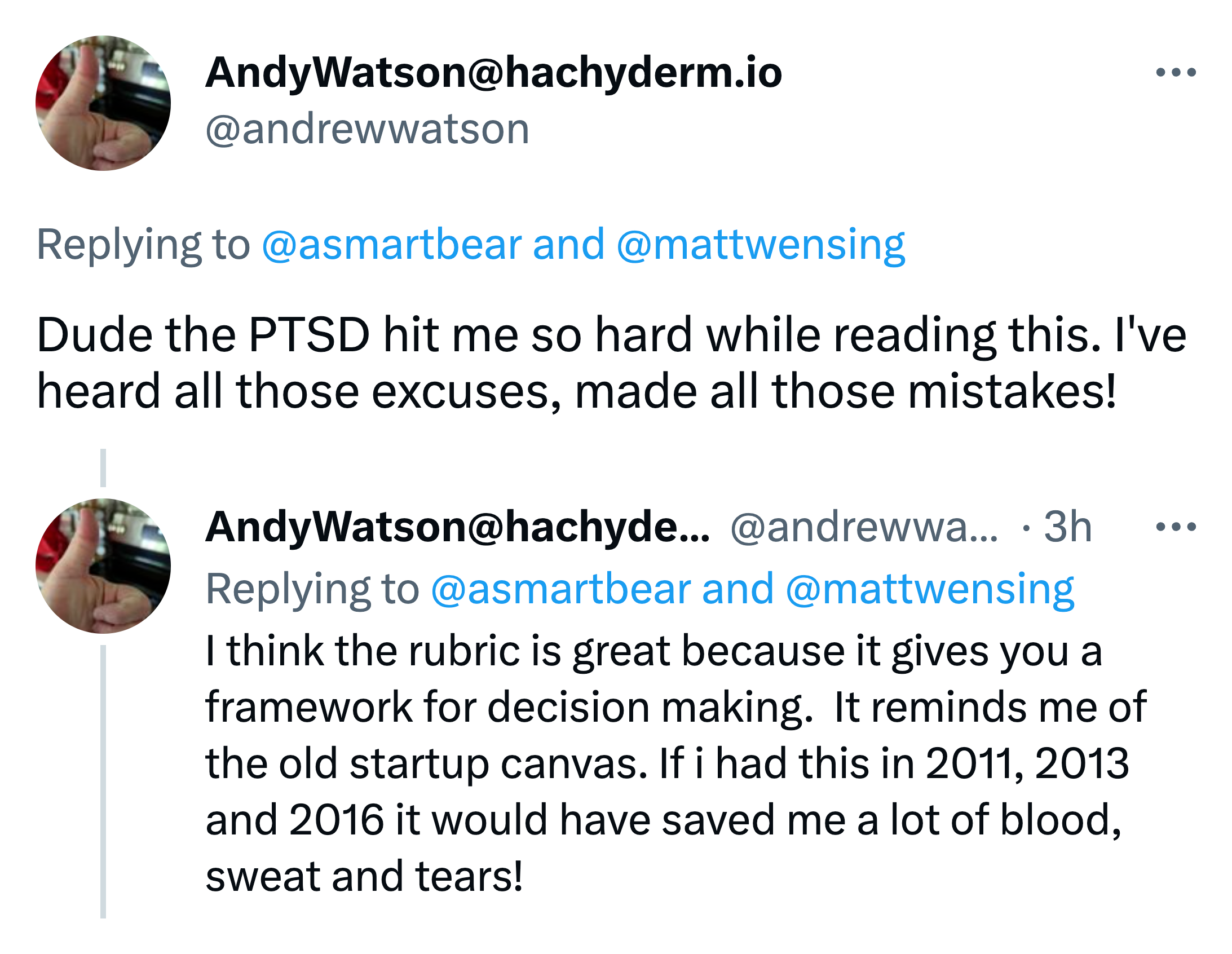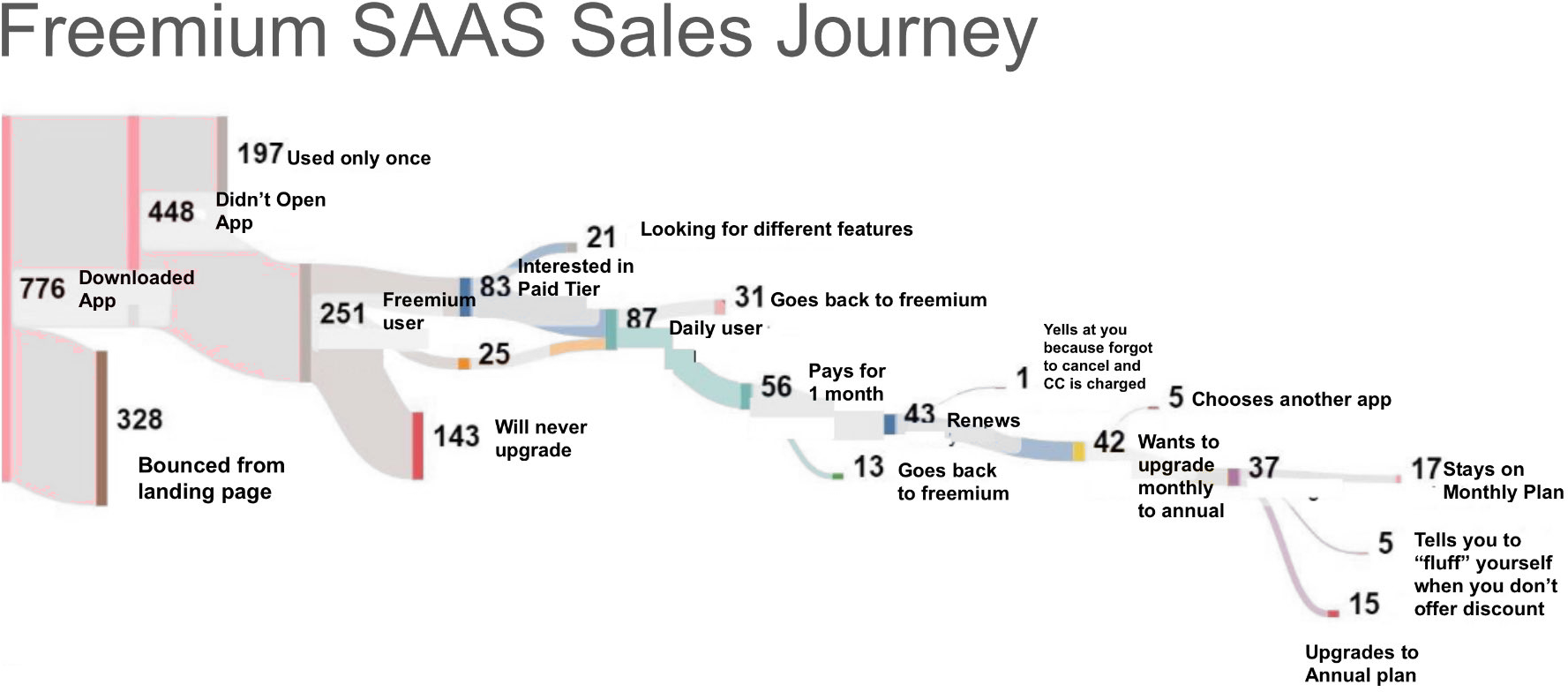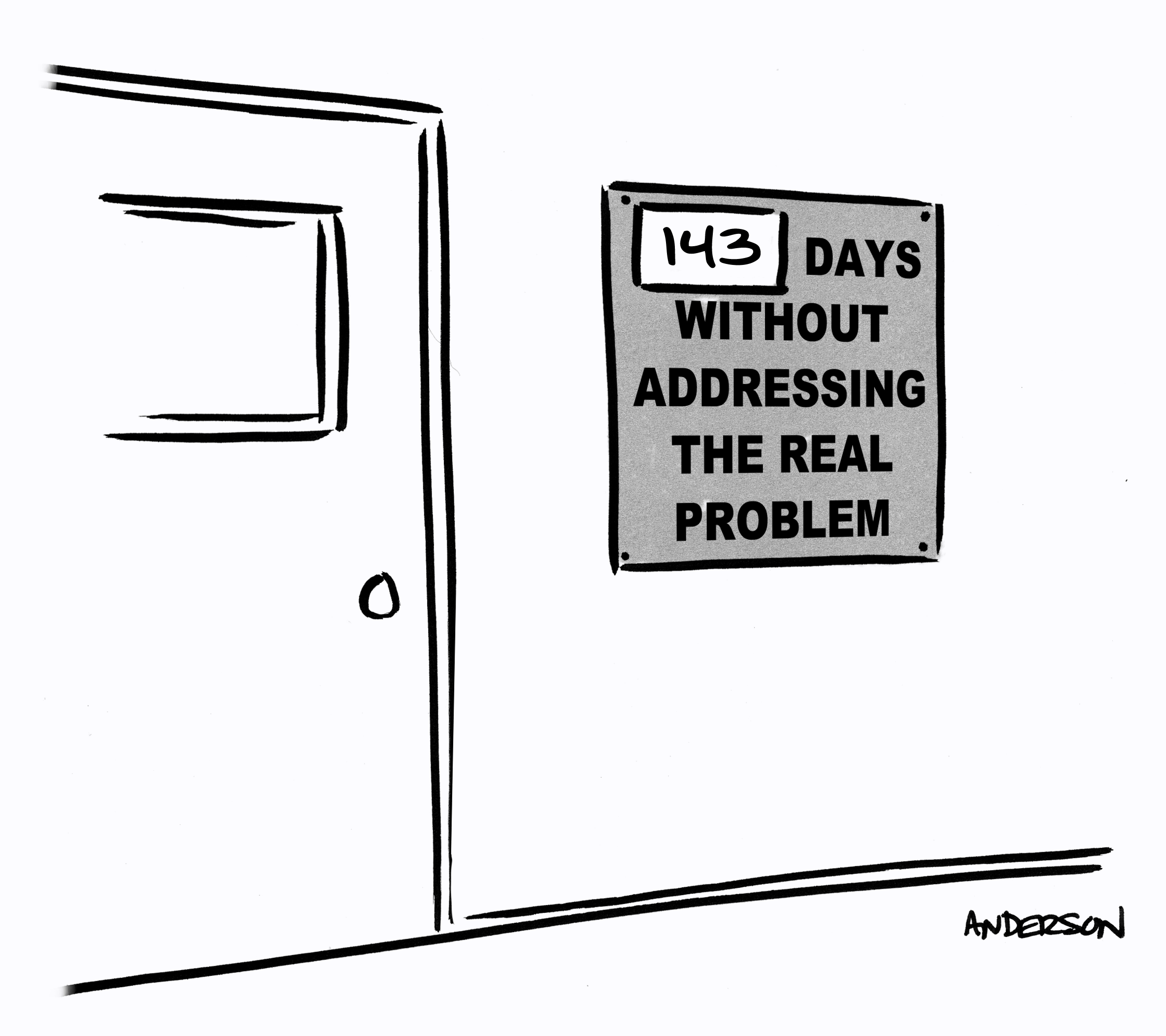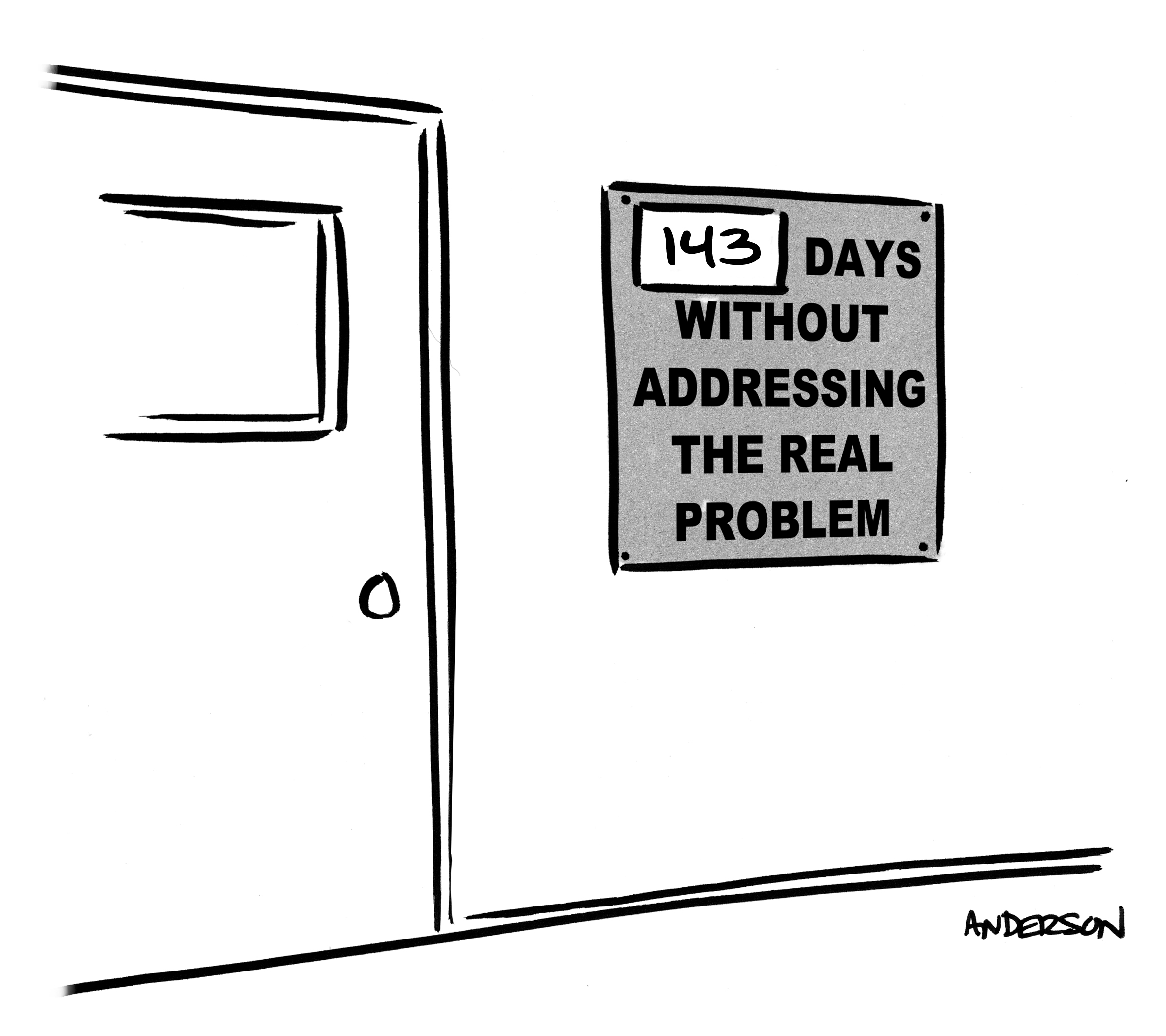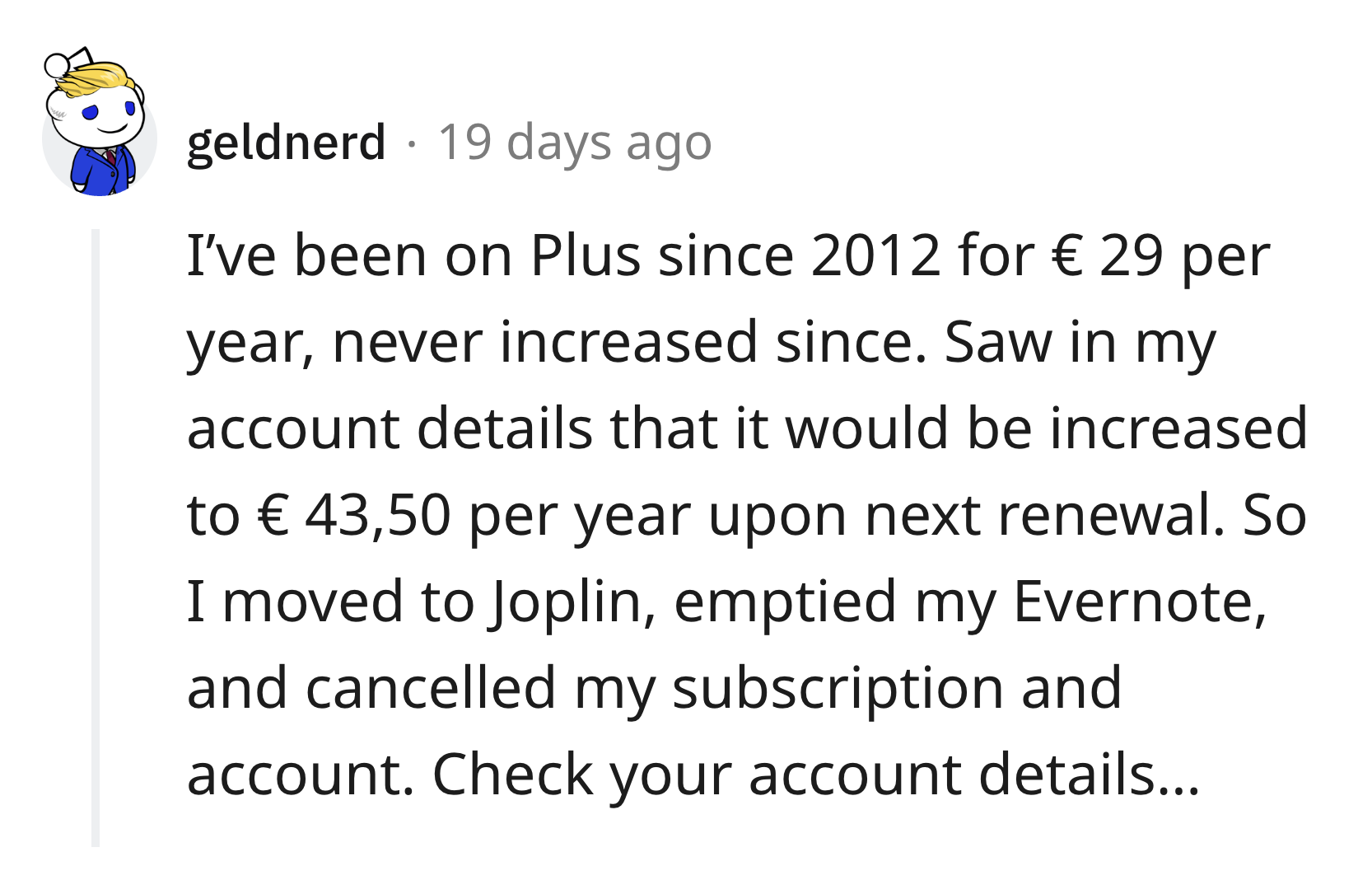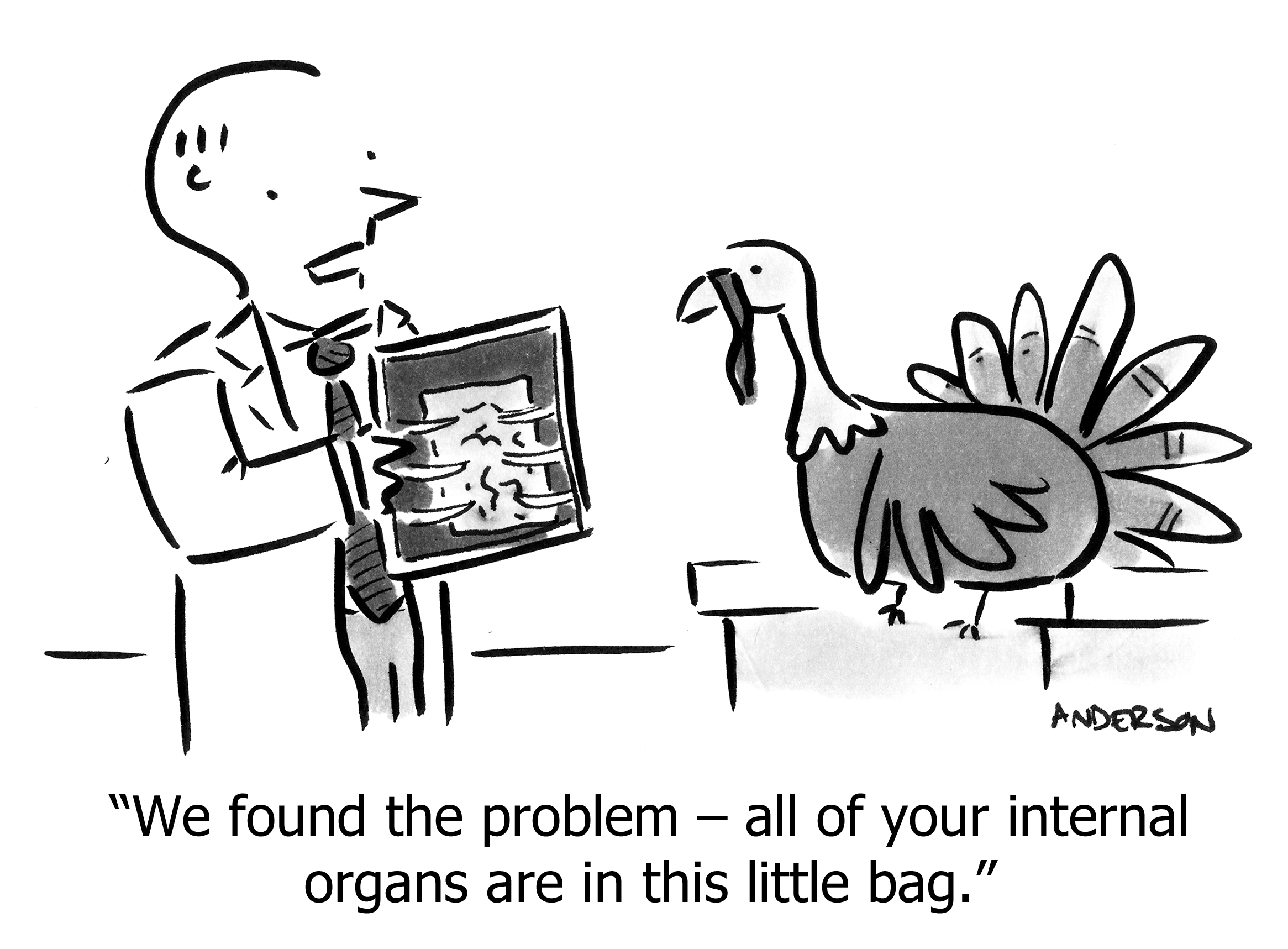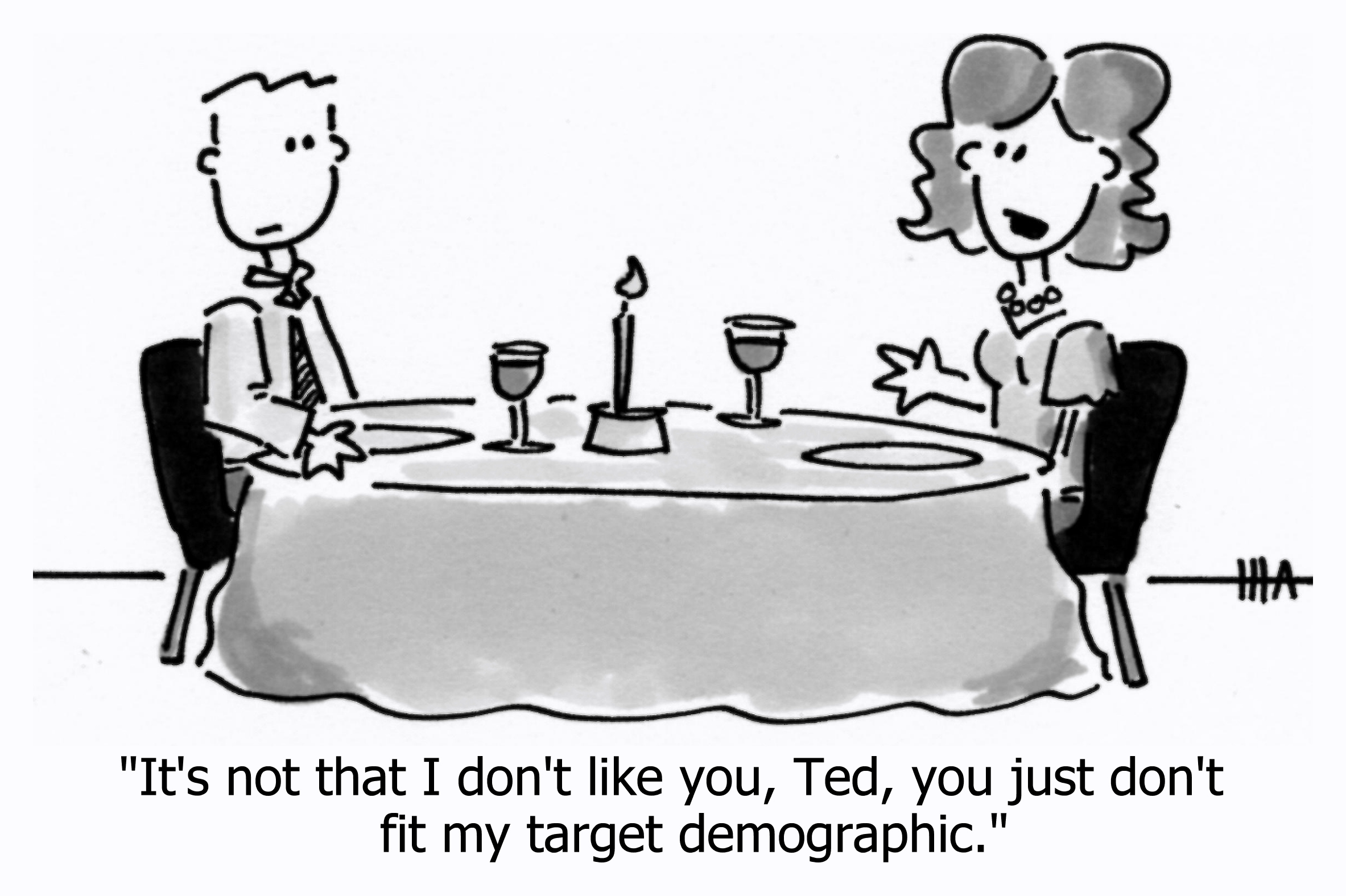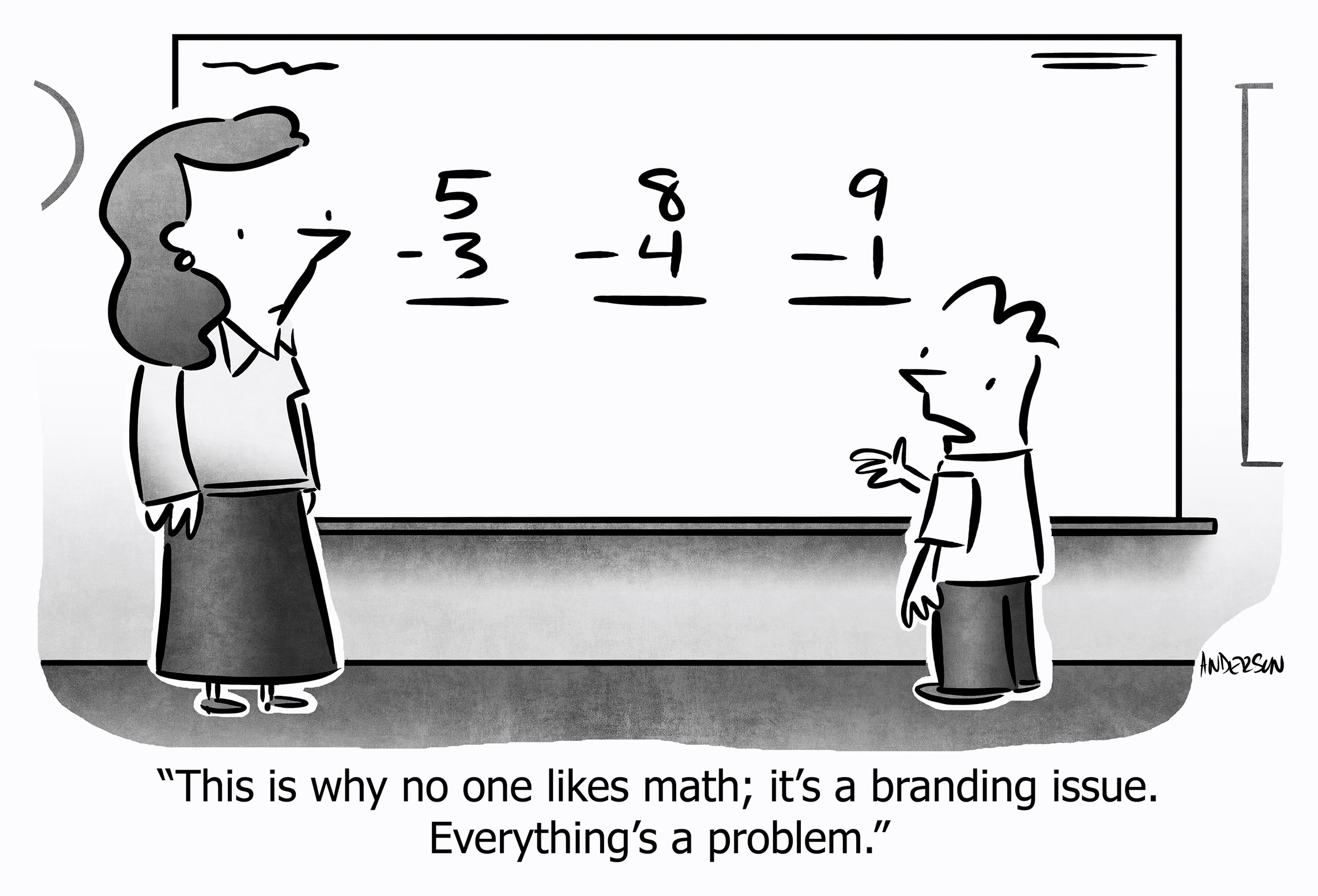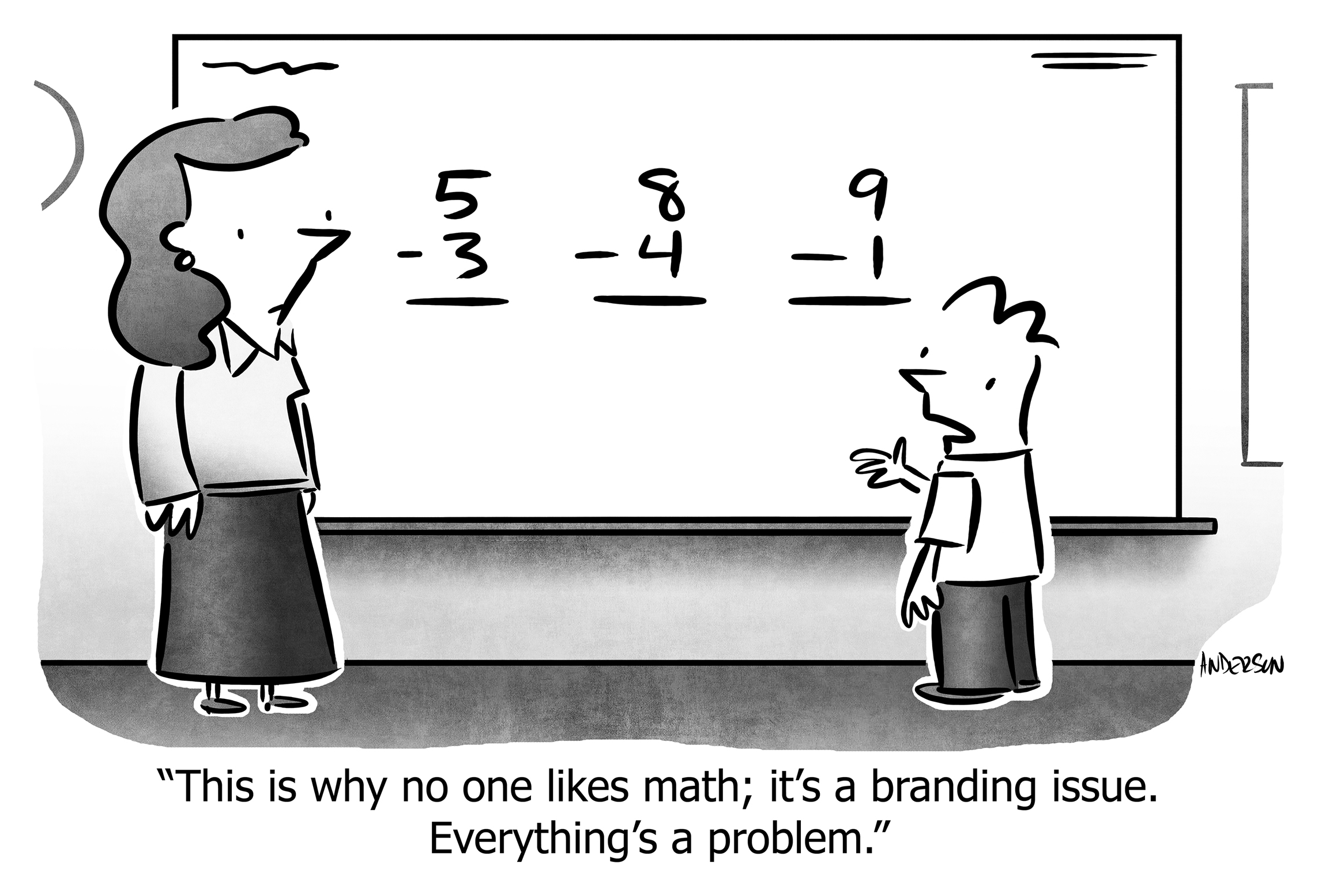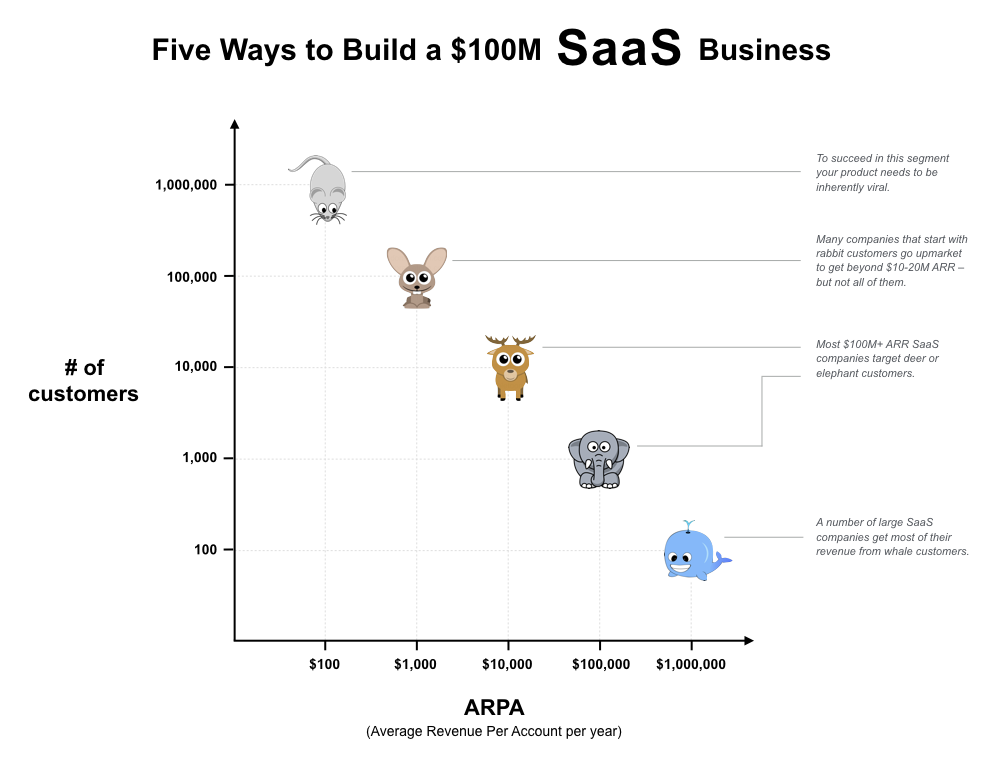Excuse me, is there a problem?
How a lot of companies fail:
- Founder gets a flash of insight: The world has a Problem.
- Founder talks to three potential customers who are experiencing The Problem, or who are expert in the domain of The Problem. They agree The Problem exists. (And they’re correct!)
- Founder builds a product that solves The Problem. (And it really does!)
- Founder fails to make enough sales, and the company shuts down in 6-24 months, when the founder runs out of patience or money.
- Founder laments into the void (i.e. posts on Twitter): Why were sales so hard when the product clearly solved a real problem?
These companies fail because solving a problem is—perhaps surprisingly—not nearly enough to build a successful company.
The following model explains an extremely common reason why this happens, and what you can do about it.
In the discussion, you’ll figure out where your challenges are, and whether you can design a strategy to side-step the issue, or whether your business simply isn’t viable.
Greatness needs luck, but it’s never by accident.
—Unknown
The path from “The Problem” to “Viable Business Model”
The main challenge facing a new startup is that so many different things have to go right for it to succeed. A subset of those things is the path “Problem” to “Viable Business Model.”
Let’s dive in.
Plausible: Do 10M people or 100k companies have the problem?
These numbers sound larger than necessary, but here’s why it is necessary even for an indie startup, using Fermi Estimation:
- 1% conversion: Impression → Visitor
- An AdWords campaign with multiple keywords, ads, and bids would be very successful at a 2% click-through rate. Display ads are more like 0.3%-0.5%. (source: HubSpot)
- Top SEO position can be 3%-5%, but that’s almost impossible to achieve for even a mildly competitive keyword. (source: HubSpot)
- 1% conversion: Visitor → Paid
- A typical, successful product website converts 1% of its traffic to paying customers. I don’t have firm data, though I did an informal poll on this question years ago. Some data show 2-5% conversion rate even for just a sign-up form or free trial, of which a fraction will become paying customers.
- Therefore: 10,000 Impressions → 1 paying customer
- 10,000 × (1% click-through) × (1% convert-to-pay) = 1.
- 10,000,000 Impressions → 1,000 paying customers
- Not every impression will be a unique person, but you still need closer to 10M potential eyeballs than to 1M, because while some people will see your material more than once, most of the market will never see your material.
1,000 paying customers is the minimum1 needed for a sustainable, small company. It will take about two years2, 10M marketing impressions, and luck.
1 This is a rough rule of thumb companies charging $30-$100/mo; if less, you’ll need even more customers to become sustainable; if more, you need fewer customers, but they are more difficult to find and convert than the numbers above suggest. Pricing determines your business model.
2 WP Engine, the company I started over a decade ago, was a hyper-growth company and then a Unicorn, reaching $100M in ARR in a similar timeframe to other hyper-growth companies (as in the chart mid-way through this article), now with over 200,000 customers, yet it took two years to get the first 1,000 customers. Competitors who started after us also took that long, and there are many many many many many many many many many many other examples. Of course it can also take forever, 4 years, 6 months, or 52 hours, because this is a rule of thumb, not a law of physics.
If you’re selling directly to consumers, there needs to be 10M who have the problem, otherwise it’s too small even for an indie company who wants to stay small forever.
If you’re selling to businesses, the total number of potential customers is an order of magnitude smaller, but they will pay orders-of-magnitude more to solve problems, and conversion rates are higher, thus 100k is sufficient.
Real-world data reinforcing this point; a relatively high 4% conversion from home page to paid, though 25% of those return to Freemium after just one month:
Trung Phan’s conversion funnel for AI research app Bearly.ai
A lot of great ideas attack problems that just aren’t actual problems, at least not for more than a small handful of people, and therefore fail to yield a successful company.
Can you be successful anyway? Yes, there’s an exception to every rule. For example, a high-price-tag product in a small niche can be a fine company. Or, perhaps you’re happy staying frugal, never hiring an employee, and making $100,000/year post-expenses post-tax, replacing a salary but on your own terms3. That’s wonderful. You can be the exception, but with conditions.
3 This is, in fact, what 80% of small businesses do. It is a vibrant and valuable driver of fulfillment and the economy; ignore those who claim this is somehow less important than “swinging for the fences.” Rather, there are two kinds of companies: Those which endeavor to replace a salary (and then some), and those who are trying to become huge, and they are simply different paths.
Self-Aware: Do they know & care they have the problem?
It seems like the answer should be “obviously yes,” but often the answer is “shockingly no.”
If a person does not already believe they have a problem, they will not be surfing the Internet looking for a solution, and even if they happen upon your website somehow, you cannot get them to spend money to solve a problem they don’t think they have.
Sam Altman is the co-founder and CEO of OpenAI, and before that ran the Y-Combinator accelerator, and is therefore one of the world’s most experienced experts on startups. He previously co-founded Loopt—a location-based, mobile social-network app. Oh look, those are all the keywords of 2005, when it was founded. It raised $30M and failed. When asked what happened, he said:
The market wasn’t there. You can’t force a market. You can have an idea, and as a startup part of your job is to be ahead of it, and sometimes you’re right about that, and sometimes you’re not.
Sometimes you make Loopt, and sometimes you make OpenAI. You just keep trying.
—Sam Altman, interviewed by Kara Swisher
I’ve given the example of website security, which I know4 is a real problem plaguing millions of websites whose owners think “those mean hackers won’t attack lil’ ol’ me; I’m nobody!” False. Hackers indeed don’t care about lil’ ol’ you, but they do want to gain control of your lil’ ol’ server, so they can do their nefarious things, like spamming, advertisement-click-fraud, remote-controlling your visitors’ browsers, or just bouncing off to yet another server as a way of covering their tracks. Everyone has the problem, but millions of people don’t think they have the problem, so they’re not searching for website security software, and certainly not buying it.
4 A million websites run on WP Engine’s platform, serving tens of billions of requests daily, as 9% of the global online population visits a WP Engine property every day. We block hundreds of millions of nefarious requests daily, and internally run SOC Type II and ISO/IEC 27001:2013 certified security processes. So we know a lot about what hackers do to websites large and small.
“Security” is a case of ignorance, but the other version of this challenge is when the customer knows they have the problem, but genuinely does not care. This could be because this problem is the ninth-most-important priority on their list, and they can only give attention to their top three… and this item will never bubble up to the top three. An example I see a lot at WP Engine is accessibility5. Given lip-service by many marketing departments and product managers, it rarely makes the priority list for the public website or the product. Some companies choose to care, or are mandated by governments or contracts. This author chooses to care6. But the fact is, though everyone agrees they have the “problem” of a non-accessible website or product, most don’t have the will to act.
5 “Accessibility” means working well for people with various challenges; in the visual sphere, consider cases like red/green color-blindness, needing high-contrast colors, needing larger text, or complete blindness, needing “screen reader” browsers to navigate menus, forms, and content.
6
This site uses semantic tags for content and navigation, the entire stylesheet of both fonts and layout supports arbitrary changes in font size, automatically respecting browser-specific settings, supplies keyboard shortcuts for menu actions, has alt-text for all images, uses aria-title and related attributes, uses high-contrast foreground/background colors, also supports high-contrast mode, and works well in screen-readers (including those built for everyone, like Safari Reader and Readwise Reader and Pocket). That said, let me know if there’s more I could be doing!
Sometimes “willing and able” is a matter of market-timing. A famous example is Instacart: Successful after 80% of Americans carried a smart phone, unlike WebVan which was exactly the same idea, solving the same problem in much the same way, but the market wasn’t ready for it.
A lot of great ideas, attacking real problems, fail to become successful companies, because the target market doesn’t know they’re even in the market. Because they’re not.
Can you be successful anyway? Yes, there’s an exception to every rule. Some founders are not only the first-and-best sales-person, but also natural evangelists. More, they’re on a mission to educate the world about their passion. They don’t see a lack of interest as a barrier, but as an opportunity to change minds. That is a difficult, expensive, and slow path7, but it is a path, and one that could result in zealous, loyal customers and a fulfilling existence. But you really have to want that path, doing that work with those consequences, if you’re going to enter a market that you also have to create.
7 “Difficult” because changing someone’s mind about anything is almost impossible, especially when they’re not seeking to have their mind changed. “Expensive” because of the marketing and attention you have to bring to the cause, on top of the usual work of making a sale, with certainly-worse-than-average conversion rates. “Slow” because you’re having to create demand and then fulfill it, rather than meet demand that already exists.
Lucrative: Do they have substantial budget to solve this problem?
- “You have a great product! I’d have to get [someone else’s] approval for this though, and they don’t understand all this.”
- “This is nice, I would use it, but they’re carefully watching all expenditures and the truth is I can manage without it.”
- “I’d love to, but our budget is closed for the year and I can’t start a new project.”
- “This is pretty cool, but our internal team who manages [the problem] says they don’t need help. They might be just trying to save their jobs, but it is what it is.”
We’ve all heard these objections. Some are normal; you can’t win every sale. But sometimes the target customer agrees they have the problem, yet doesn’t have the money to solve it.
At Capital Factory8, there’s a constant stream of kids coming out of college with a startup that “sells ______ to college students.” It’s easy to find “problems”—restaurants and bars want to advertise to students, students don’t want to spend much on food, students need books and supplies, and so on. The founders explain they “had the problem themselves, so they really understand it.”
8 Capital Factory is by far Austin’s largest and most prolific “Center of gravity for entrepreneurs in Texas,” now a tiered system from co-working to mentoring to multi-million-dollar investments with hundreds of companies in orbit. The University of Texas, also in Austin, has a high-quality Computer Science department that is also one of the largest in the country.
That’s probably true. The deal-breaker is that college kids have no money, and don’t spend what little money they have on SaaS products. And businesses that cater to college kids have to charge low prices (because college kids have no money), and therefore don’t have budgets for oddball new ideas. In 15 years, none of these startups worked, even though arguably most of the “problems” existed.
You might think a large company will definitely allocate budget for a known problem, but here again the answer is often in the negative. Budgets are applied to the top few most-important problems of the year; if this is a problem, but not a top one, it won’t get attention. Large companies have to allocate more than money—they have compliance teams who have to approve, they compare multiple vendors, they run pilot programs, and all of this won’t be set in motion unless it’s a top problem.
Large companies have internal teams that are already tasked with the problem, which might means there’s no additional budget for outside solutions. Those teams often fight against outside tools that are seen as making their jobs obsolete, or at least converts them into vendor-managers instead of innovators. You want to target companies who outsource this particular problem to outside vendors.
Once you get over the hurdle of there being a budget at all, is the budget large enough? I’m always shocked how little people will pay for productivity applications like to-do lists and note-taking. These are applications you might use dozens of times per day, as much as email. The slightest increase in efficiency or even simple delight will have a massive impact on the customer’s life, every day. And yet people complain that the Pro version of Bear App9 is a whopping $15/year, or that Remember the Milk is $40/year, or how they’ve been paying €29/year for Evernote for eleven years, but a change to €43 is so devastating that they will completely change to another application that has 1/10th the functionality and no tech support:
9 My note-taking application of choice, and not just because it’s called “Bear!“
In general, consumers don’t like paying for stuff, hence the multi-trillion-dollar success of having people “pay” with attention (advertisement) and data (privacy). This is why I think10 self-funded companies in particular should target businesses as customers; unlike consumers, they will spend money to solve problems and to make more money.
10 This is clearly a personal bias. I can’t wrap my head around the mentality described above, and that’s why I don’t build in and generally don’t invest in B2C—I’m fully aware that I don’t understand the customer!
A lot of great ideas, attacking real problems that customers acknowledge and seek solutions for, are in areas where budgets don’t exist, or not often, or are so small that it requires an enormous number of customers to make money (often also in a crowded competitive space), and therefore the company fails.
Can you be successful anyway? Yes, there’s an exception to every rule. If there are a huge number of potential customers, and if your cost-basis is extremely low11, you can create a strategy targeting a large market at a low price with a simple product12. This works even better if existing products are poor (so you can stand out and make a splash) and expensive (so your low price is itself a differentiator). It’s still risky and difficult, but you could accept that and make decisions consistent with that challenge. But you have to really want that path, and increase the “10M” number, since you’ll need a lot more customers to make ends meet.
11 e.g. no direct customer service, no substantial infrastructure costs, a route to market that costs almost nothing to acquire a customer, the ability to build and maintain the application with very little design or engineering or product outside of the founders, switching costs are low so you don’t have to do a lot of work or spend a lot of money to get a customer off another product and on-boarded onto your product
12 When a product will be widely used with little-to-no customer service, it must be simple or it won’t scale.
Liquid: Are they willing and able to buy right now?
- “Oh yeah, we spend $100,000/year on this. But our contract isn’t up for renewal for another 15 months.”
- “We just implemented a version of this in Workday. I’d rather use your product actually, but it’s just part of Workday and the HR team likes that everything is integrated.”
- “This is way better than our current system, but we’ve invested a lot integrating with seven other systems, plus a few custom things some engineering teams did, so we can’t really consider switching away at this point.”
- “That looks like great software for weddings. I’ll let you know when I get married again! Haha!”
When the customer is already paying to solve the problem, or actively comparing options to solve the problem, you still run into the barrier of whether they have the organizational will to buy from you.
This can be for legal reasons, like being locked into a long-term contract or government fiat. This can be for convenience, as in the Workday example which at WP Engine caused us to cancel several other SaaS products because “now it’s all in one system, which we’re paying for anyway, so this is simpler and safer to manage.” This can be because of other forms of lock-in, like difficulty in extracting and moving existing data, having to retrain thousands of employees, or having to re-implement a variety of cross-systems integrations that people rely on for their workflows, data, reports, and governance.
Notice that all these forces have nothing to do with your product or its price. They are so powerful, they overwhelm a product that is solving the problem the best, at the best price. That’s why they cannot be ignored, and why founders are surprised when their genuinely-great product in the definitely-extant market where customer are definitely paying for solutions, is still too difficult to sell.
On the bright side, this is a prompt for your strategy. How will your strategy create these sorts of “lock-ins” that will prevent your competitors from kicking you out of your customers?
A final way that customers might not be able to buy right now, is when the product is needed at a specific moment in time, but not before or after that moment. Websites for events and occasions are an example, as are tools that solve temporary problems like sophisticated code profilers or load-testing tools. Because Smart Bear13 was in the developer tools market, I know a number of founders of products in the latter two spaces; all of them struggled to maintain even small companies, exactly because people didn’t proactively need the product (i.e. “Don’t have the problem”), but then suddenly did (i.e. “Willing to buy, but only right now”), and then didn’t any more (i.e. “No longer willing to buy”).
13 My company before WP Engine and the namesake of this website.
Can you be successful anyway? Yes, there’s an exception to every rule. If there’s a legal contract, you can offer to pay the penalty for them breaking their contract (so long as that isn’t so expensive that you can never be profitable). If it’s hard to migrate, you can offer to do the migration as a service, perhaps even for free (this is common in WP Engine’s market). If you’re fighting the all-in-one enterprise systems like Workday, you can focus instead on a target market that cannot afford Workday and sees Workday as overly complex and cold, so that Workday isn’t even a competitor. If timing is important, you might offer a way to buy that is cheap or even free while not using it, so you’re “right there as soon as you need us again.” But you have to really have answers for these challenges, and be ready to walk that path.
Eager: Do they want to buy from you, specifically?
- “It seems like it would work for us, but it looks like you’ve only been in business for a year?”
- “It definitely worked fine during the trial, but we’re expecting to grow 100x and we’re not confident that you’ll be able to handle it.”
- “For the features we need, [competitor] looks the same to us, and they’re cheaper.”
- “I like how you do X, but [competitor] does Y and Z, which we really like, so we’re going with them.”
- “Our policy requires that all vendors are SOC 2-compliant and provide a security audit trail API, so you did not meet our basic requirements.”
Even in a real market, with customers spending real money, in a purchasing process right now, you haven’t yet won. There are other options, ranging from direct competitors to indirect alternatives. They will buy, but will they buy from you?
The first hurdle is trust: Do they trust not only that the product works, but that your company will be around for many years to come, that you will maintain a high pace of development, that you won’t have security issues, that your customer service will truly help them when inevitable problems arise, and that you can scale as the customer’s needs scale?
The second hurdle is differentiation. This doesn’t just mean “you have something unique.” You might have a feature that no one else has, but if only 10% of the market cares about that feature, that’s not enough. Worse, your competitor will have some feature you don’t have, and what if 30% of the market cares about that one? How to do this? See this companion article on leverage.
A special difficulty comes when the product over-serves a large segment of the market. This means that, for example, you have ten features, but most of the market really cares about three of them. You might have all sorts of differentiation in the latter seven, but that won’t sway most people. Picking something simpler or cheaper is the rational choice, even though your “feature comparison matrix” shows that you’re a much more complete solution.
A sales team can combat both of these challenges. The job isn’t just to schedule calls, cajole potential customers into action, and press for the close; the job also to build trust in your organization and talk around competitive points, positioning so that the customer wants to buy from the mixed bag of plusses-and-minuses that every product contains.
The best way to overcome these challenges are the “Love” and “Utility” types of willingness-to-pay.
Can you be successful anyway? Yes, there’s an exception to every rule. Trust can be side-stepped by building a type of product that doesn’t require much trust14. Or trust can be built by mitigation, for example open-source means the customer can shift to another vendor or take over the code base in a worst-case scenario. Differentiation is harder. Sometimes you’re competing on price, which isn’t ideal for the bottom-line or for the quality of customer, but can work very well. In a large market, differentiation can come from specializing in a niche. In a small market, you might not have many viable competitors, lessening the importance of differentiation. A company mission that is “bigger than all of us” can also be a distinguishing reason to buy15, although typically more for consumer products where that’s an allowable purchase-criterium. Still, it difficult to survive when you’re no different from more mature, feature-rich, stable, innovative alternatives.
14 “Security” isn’t a concern if the data in your app isn’t private, such as a social media management tool. “Uptime” isn’t a concern if the product is run locally or the service isn’t time-critical. “Company maturity” isn’t a concern if it’s a tool for individual use; in fact it can be an advantage for a new startup to sell to freelancers or other people who want to support other startups.
15 People buy windbreakers from Patagonia that are undifferentiated from other outdoor apparel vendors, because Patagonia is well-known for spending hundreds of millions of dollars on conservation and sustainability, and for treating their employees well.
Enduring: Will they still be paying (or paying-it-forward) a year from now?
I cannot count the number of indie developers who grow to $15k MRR and start slowing down because their cancellation rate is 7%. Many don’t think this is a problem; many of the rest believe that 5% would be a success. It’s not.
Financials and SaaS metrics aren’t even the primary reason why this is fatal. The problem is that the customers don’t want the product. 5%/mo cancellation means only half the customers will still be customers a year from now, which means you’re not building a sustainable business.
The reasons can vary. Perhaps they needed the product temporarily; they might have loved it, but “the problem” disappears. More often, the product didn’t work well enough—insufficient features, too many bugs, didn’t integrate with some other system, too expensive for the end result, turns out the problem is not important enough.
The financial reality is illuminating too. The challenge is that top-line growth is linear for many companies, and quadratic (not exponential) even with hyper-growth companies. But cancellation is exponential—that’s why it’s measured as a percent of the current customer base. Exponentials grow faster than lines or quadratics, therefore cancellation “catches up” faster than you can add new customers. Growth fades, and finally ceases, as one customer cancels for every new customer who signs up.
With $15k MRR, adding $2k/mo of new customers—a healthy 15% per month growth rate—a 7% cancellation rate means already half of that growth is negated by customers leaving. The company barely got started and already its growth is being decimated. At that rate, only one year later, having grown to about $27k MRR, the company has stopped growing completely16, despite spending time and money on marketing and sales. Don’t forget—those new customers cost money to attract, sell, and on-board with tech support, but all the value of that expense is negated by an equal number of customers walking out the door.
16 Growth stops because the $2k of new customers arriving in a month are negated by $27k × 7% ≈ $2k customers cancelling in that same month.
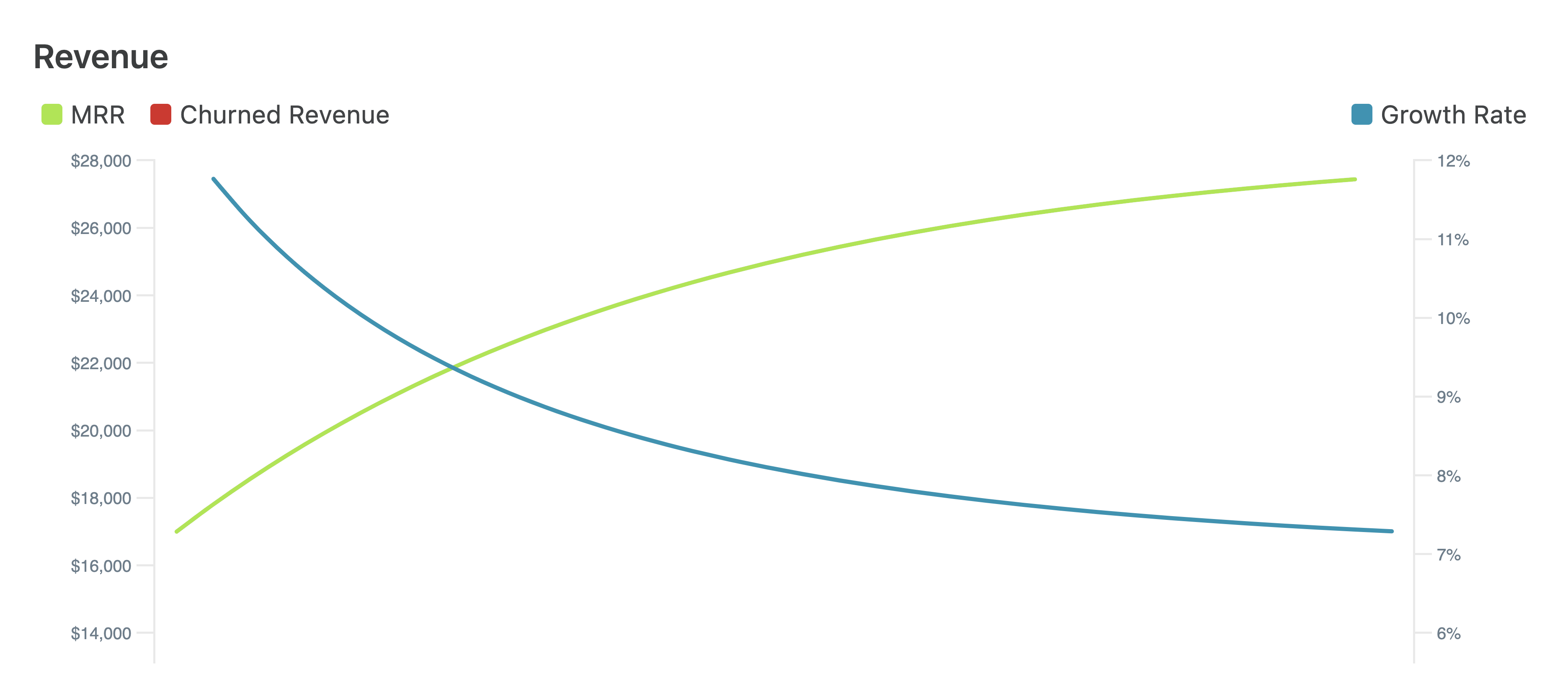
Charting this scenario using the SaaS Plateau Forecaster from Summit.
You certainly aren’t required to have a goal of “grow forever17,” but capping growth because customers don’t really value your product, is not a healthy business no matter what your end goal is.
17 But especially if you do have the goal of becoming a scale-up Unicorn, it is impossible to do that without low churn. As just one example, Gainsight CEO Nick Mehta recently pointed out why “This stall will happen to all companies eventually,” explaining that launching a second product was their solution.
This example was for a recurring-revenue business, but the same principle is true for one-time revenue businesses. One-time revenue businesses still require repeat revenue, in two ways:
- Customers buying again.
- Happy customers telling other people to become customers.
Both of these require that customers are happy with the product. This reinforces the point that the most important problem is that the customer isn’t satisfied, regardless of business model.
Can you be successful anyway? Yes, there’s an exception to every rule. Shopify is a fantastically successful business with a 8% cancellation rate—only 34% of new customers stick around for one year. They’re successful anyway because (a) the ones that do stay tend to grow forever and super-linearly, (b) the market is enormous and still growing fast, so they won’t run out of new customers anytime soon, and (c) customers cancel because their own business didn’t succeed, not because Shopify’s product is problematic. If the problem really is the product, I don’t believe there is an exception. The product has to be work well for some segment of the market. The rest can be mitigated if other factors of the market, strategy, and business model can overcome this massive weakness with even-more-massive advantages.
Evaluating startup viability
This path of “problem” to “business model” is not the only factor that determines success. There are still questions like whether you can reach customers, get their attention in the noisy Internet and competitive space, can you do that cost-effectively, are company costs too high, do you have the skills, can you hire for skills, do you have enough time and money to do it, and so on.
Still, we can evaluate the viability of this path with the following model. We’ll use Fermi Estimation to avoid the analysis-paralysis of deep research and arguing over details.
Some people have already started using this to think through their businesses, like Sam Bhagwat, co-founder of Gatsby, thinking through his next startup. There’s also some online calculators if you like that sort of thing.
Answer with regard to a specific target market, which means a specific type of buyer solving a specific problem with a product that has made specific trade-offs, at a specific price.
| Criteria | Score |
|---|---|
| Plausible Number of potential customers (consumers or businesses) who actually have the problem |
Power-of-ten only 1k, 10k, 100k, 1M, 10M, 100M, 1B |
| Self-Aware Willing to solve the problem |
0.01: Few agree or care 0.1 : Thought-leaders care and evangelize 0.5 : It’s an industry standard-practice 1.0 : Almost impossible to find someone who doesn’t care |
| Lucrative Annual allocated budget |
Power-of-ten only, of net-revenue18 $1, $10, $100, $1k, $10k, $100k, $1M |
| Liquid Frequency of purchase decision |
0.01: Every few years 0.1 : An annual decision 1.0 : Always in the market, easy to switch |
| Eager (identity) Attitude towards your company |
0 : They cannot buy from you 0.1 : Structural challenges 0.5 : Indifferent; no red flags 1.0 : Mission-level emotional desire to select you |
| Eager (comparative) Competitive differentiation |
0.1 : No material differentiation 0.5 : Some features are so good, some people will buy just for that 1.0 : One-of-a-kind solution that has no viable alternative |
| Enduring Will they still be here a year from now? |
0.01: One-off purchase without loyalty 0.1 : One-off purchase, but happy customers will buy again and tell their friends 0.5 : Recurring-revenue from a recurring-problem 1.0 : Strong lock-in from fiat, integrations, or being the system-of-record for a business-critical system |
| Normalize Normalize the score so that 1 is the threshold for an indie startup, 2 or more for a scale-up.19 |
Divide by 625,000 |
Now you multiply. Why multiply? Because this is a series of “ands”—there needs to be customers with the problem and they have budget and they are buying today and so on. The effects compound.
18 “Net-revenue” means your revenue after subtracting pass-through costs. For example, an eCommerce platform might process a $100 purchase on behalf of its customer, keeping $10 for itself as payment; that is net-revenue of $10. Pass-through costs do not include cost-of-goods-sold, i.e. you should not subtract out the marketing and sales costs to acquire the customer, nor customer support, nor infrastructure costs for SaaS products. Those are important for profitability, but in this exercise we are focused only on top-line revenue, not on the efficiency of your operations.
19
Justification: Using the figures earlier in the article, you could be successful with 10M consumers at $10/mo, or 100k businesses at $1000/mo (e.g. dentist practice-management), so consider the threshold of those numbers combined to be 100M. Taking the middle value of all other questions—neither a deal-breaker nor a strong advantage—you end up with 100M × 0.5 × 0.1 × 0.5 × 0.5 × 0.5 = 625k. Arguably you should have some strong advantages, but also some of these values will be on the low side, so this is a reasonable Fermi-style acceptance threshold.
This is dangerously close to a silly quiz or rubric, so we have to be careful to use the final score as guidance rather than precise analysis. Still, different choices of target market, target customer, and product trade-offs can result in dramatically different results.
As usual, having to think through the answers and trade-offs is most of the value of the exercise, even more than the final score.
A few examples
Still, let’s try it, using WP Engine20 as the example. Note how our research is simplistic, but because we only have to be accurate to a power of ten, the answers are easy anyway21:
20 WP Engine is the largest platform for WordPress-based websites among the top ten million websites in the world. Therefore, we’ll take the market as “businesses using WordPress.“
21 For example, our figures for the first row are just page-one Google search results, but even if the figures are off by 50%, certainly the true answer must be far larger than 10M and far smaller than 1000M, hence 100M is the easy choice.
| Criteria | Score | Justification |
|---|---|---|
| Plausible Number of businesses who have the problem |
100M |
There are 334M businesses in the world, 71% of which have a website. 43% of websites are WordPress. |
| Self-Aware Willing to solve the problem |
0.1 |
While everyone using WordPress definitionally hosts it somewhere, and industry practitioners often use a specialist vendor, most target customers don’t care enough to do more than the bare minimum. |
| Lucrative Annual allocated budget |
$100 |
Difficult to say over such a large market; one could argue that $10 is more accurate because most businesses are small and most don’t buy expensive American things. |
| Liquid Frequency of purchase decision |
0.01 |
People rarely change their website platform. |
| Eager (identity) Attitude towards your company |
0.5 |
Could argue that it is 1.0 today because of our leadership position, but ten years ago we were one option among several, all of which were viable for many customers. |
| Eager (comparative) Competitive differentiation |
0.5 |
We have many capabilities and features that are either unique or we are the best, but competitors have other advantages, whether in features or price or geography. |
| Enduring Will they still be here a year from now? |
1.0 |
Today we easily justify this with our world-class retention metrics across 14 years of customer data, however even early on we saw high retention, and comparables also have high retention. |
Score =
2,500,000 / 625,000 = 4, so it qualifies as a scale-up, and indeed that’s what happened.
Let’s try it again with an indie startup: ConvertKit, a email marketing product competing with giants like Constant Contact and newcomers like Substack, designed to help you grow and then monetize your subscribers. They target creators who want to monetize their newsletters, not “anyone and everyone,” which reduces the target market but increases willingness-to-pay.
| Criteria | Score | Justification |
|---|---|---|
| Plausible Number of people who have the problem |
10M |
There are tens of millions of newsletters using competing products. |
| Self-Aware Willing to solve the problem |
1.0 |
This is well-known as a best-practice, with multiple at-scale companies serving a mature market. |
| Lucrative Annual allocated budget |
$100 |
Customers with complex workflows and many thousands of subscribers will pay more, but most customers aren’t in that category, and might pay $9/mo.22 |
| Liquid Frequency of purchase decision |
0.01 |
Customers buy newsletter software and then want to just use it, not be switching |
| Eager (identity) Attitude towards your company |
0.5 |
The founder was well-known among other indie founders, however in the broader market there’s no reason not to trust them, but no particular mission-driven reason to pick them either. |
| Eager (comparative) Competitive differentiation |
0.5 |
Most features are similar, but there are interesting things at the margins for routing readers through flows and monetizing content, whereas more generic newsletter products don’t have as many tools for direct monetization. |
| Enduring Will they still be here a year from now? |
0.5 |
For the customers who avail themselves of complex automations, this would be a 1.0; most people will probably use it as a normal newsletter, with a simple follow-up flow that competitors also provide. |
22 Alternately, you could focus on the customers who pay more; you might then reduce the “number of people who have the problem” to1M, and the annual budget to$1000. While results in same score, it’s a different product, serving a different market, so this is an important decision.
Score = 1,250,000 / 625,000 = 2. This is a good business model, possibly even a scale-up, and indeed ConvertKit grew quickly as a bootstrapped company, and while not a Unicorn, is an order of magnitude larger than most small businesses ever become.
Finally, let’s take the case of selling security software to consumers. This is a tough market; there are success stories (e.g. Norton, 1Password, Cloudflare), but it’s hard to find small indie companies who are successful in this area (whereas it’s easy to find successful indie WordPress hosting companies):
| Criteria | Score | Justification |
|---|---|---|
| Plausible Number of people who have the problem |
1B |
There are ~5B people online today, who might have online security concerns |
| Self-Aware Willing to solve the problem |
0.01 |
Have you bought special security software for an online project? Almost no consumer does. |
| Lucrative Annual allocated budget |
$10 |
Consumers don’t pay much for things, and globally consumers spend far less on average than Americans on equivalent online goods; arguably this should even be $1. |
| Liquid Frequency of purchase decision |
0.01 |
Consumers are rarely in the market. |
| Eager (identity) Attitude towards your company |
0.5 |
Unclear without specifics, we’ll be generous and assume you can earn trust despite being an unknown brand. |
| Eager (comparative) Competitive differentiation |
0.1 |
Consumer-grade security products are undifferentiated. |
| Enduring Will they still be here a year from now? |
0.5 |
Consumers cancel at higher rates than businesses, but at a low price this could be something that is easy to maintain; industry data would be helpful. |
Score =
25,000 / 625,000 = 0.04. This is not a good business model.
But there’s hope…
What to do with a negative answer
We don’t have to give up just yet.
What if the security company targets high-net-worth individuals instead of “everyone?” The “number of people” would fall to 1,000,000, but willingness to solve the problem might rise to 1.0, and budget certainly rises to $100 if not $1000. The orders of magnitude can change dramatically, which might reveal a workable model.
What if the security company targets mid-sized businesses? The number of organizations is smaller than the number of consumers (but is still large), willingness to solve is very high (they have security policies and fear of the downside of a security incident), budgets are substantial, and so on.
In general, targeting a niche often results in a better business model, because although it reduces the number of target customers, it can increase several other numbers. This is very often the right answer whether your goal is to build a small, profitable, sustainable business (in which you stay in that niche forever) or a large multi-billion-dollar enterprise (in which the niche is your way to get started, and you expand the target market over time).
I’d rather be wrong than do something wrong.
—Larry Ellison
Or, finally, your business idea might simply not be viable. That is a sad and tough reality to face, but it’s better to figure that out early, so you can spend your time finding a new idea.
I hope this framework helps you build a winning strategy!
Further Reading
- Five ways to build a $100M business, the classic by Christoph Janz that uses five animals to show the different orders-of-magnitude of price versus size of company and quantity of those companies. This is equivalent to two of our rubric lines.
- Pricing determines your business model: How orders-of-magnitude in pricing changes your product and target market.
- How to use the Needs Stack to determine both features and benefits that make sense for your customers.
- The factors that cause customers to be willing to pay more for a product.
- Trading off many customers at low price-points versus few at high price-points.
- Why selling to the mid-market can be the “worst of both worlds.”
- How small companies can win against Enterprise incumbents.
- Selling to Carol: How targeting your one “perfect” customer is the right way to market in general.
https://longform.asmartbear.com/problem/
© 2007-2024 Jason Cohen
 @asmartbear
@asmartbear
